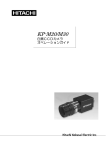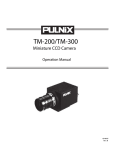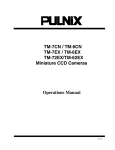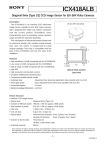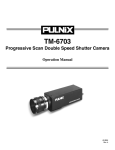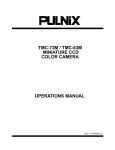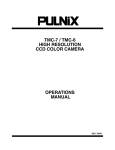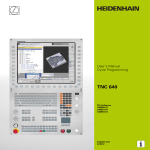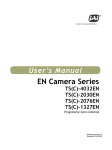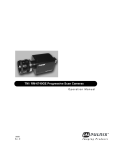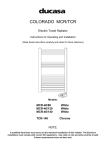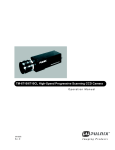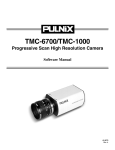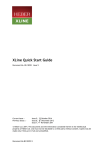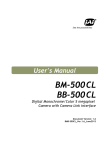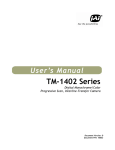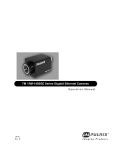Download User manual
Transcript
TM-7EG (RS-170) TM-6EG (CCIR) High Resolution Miniature Cylindrical Camera Operation Manual January 7, 2000 69-0045 Rev. A Notice The material contained in this manual consists of information that is proprietary to PULNiX America, Inc., and may only be used by the purchasers of the product. PULNiX America, Inc. makes no warranty for the use of its product and assumes no responsibility for any errors which may appear or for damages resulting from the use of the information contained herein. PULNiX America, Inc. reserves the right to make changes without notice. Warranty All of our solid state cameras have a full three-year warranty. If any such product proves defective during this warranty period, PULNiX America, Inc. will repair the defective product without charge for parts and labor or will provide a replacement in exchange for the defective product. This warranty shall not apply to any damage, defect or failure caused by improper use or inadequate maintenance and use. Certifications CE Compliance The TM-7EG/TM-6EG has been certified to conform to the requirements of Council Directive 89/336/EC for electromagnetic compatibility and to comply with the following European Standards: Immunity: EN500082-2/1995 Emissions: EN55022:1995 Class A / CISPR 22:1993 All PULNiX products bearing the CE mark have been declared to be in conformance with the applicable EEC Council Directives. However, certain factory installed options or customer requested modifications may compromise electromagnetic compatibility and prohibit use of the CE mark. Please note that the use of interconnect cables that are not properly grounded and shielded may affect CE compliance. Contact the PULNiX Applications Engineering Department for further information regarding CE compliance. FCC This equipment has been tested and found to comply with the limits for a Class A digital device, pursuant to Part 15 of the FCC Rules. These limits are designed to provide reasonable protection against harmful interference when the equipment is operated in a commercial environment. This equipment generates, uses and can radiate radio frequency energy and, if not installed and used in accordance with the instruction manual, may cause harmful interference to radio communications. Operation of this equipment in a residential area is likely to cause harmful interference in which case the user will be required to correct the interference at his own expense. WARNING Changes or modifications to this unit not expressly approved by the party responsible for FCC compliance could void the user’s authority to operate the equipment. TM-7EG/TM-6EG Operation Manual Printing: January 2000 PULNiX America, Inc. 1330 Orleans Drive Sunnyvale, CA 94089 Tel: (408) 747-0300 Tel: (800) 445-5444 Fax: (408) 747-0880 E-mail: [email protected] www.pulnix.com TABLE OF CONTENTS 1 INTRODUCTION.............................................................................................................. 1 1.1 1.2 1.3 Product Description and Applications .................................................................................................1 Features ..............................................................................................................................................1 System Configuration..........................................................................................................................3 2 INSTALLATION ............................................................................................................... 4 2.1 Getting Started....................................................................................................................................4 2.1.1 Unpacking Instructions ..............................................................................................................4 2.1.2 Components List .......................................................................................................................4 2.1.3 Accessories and Options ..........................................................................................................4 2.1.4 Power Supply and Power Cable Setup......................................................................................5 2.1.5 Attaching the Camera Lens.......................................................................................................6 2.1.6 Auto-Iris Lens Setup..................................................................................................................6 2.1.7 Monitor Display Mode................................................................................................................6 3 MODES OF OPERATION................................................................................................ 6 3.0.1 3.0.2 Timing .......................................................................................................................................7 External Input Signals ...............................................................................................................8 4 TROUBLESHOOTING..................................................................................................... 9 4.1 Problems and Solutions ......................................................................................................................9 4.1.1 Symptom: No Video...................................................................................................................9 4.1.2 Symptom: Dark Video................................................................................................................9 4.1.3 Symptom: Non-synchronized Video ..........................................................................................9 4.2 Information and Support Resources .................................................................................................10 5 APPENDIX..................................................................................................................... 11 5.1 Specifications....................................................................................................................................11 5.1.1 Product Specifications.............................................................................................................11 5.1.2 Physical Dimensions ...............................................................................................................12 5.1.3 Glass Specifications ................................................................................................................13 5.1.4 C-Mount Specifications ...........................................................................................................14 5.1.5 Spectral Response ..................................................................................................................15 i LIST OF FIGURES FIGURE 1. TM-7EG/TM-6EG System Configuration ............................................ 3 FIGURE 2. TM-7EG/TM-6EG Assembly Drawing Showing Flying Leads............. 5 FIGURE 3. Timing Chart ....................................................................................... 7 FIGURE 4. External Input Signals......................................................................... 8 FIGURE 5. Physical Dimensions......................................................................... 12 FIGURE 6. Camera Front End - Glass Specifications......................................... 13 FIGURE 7. Combination With “CS-Mount” Camera ............................................ 14 FIGURE 8. TM-7EG/TM-6EG Spectral Response .............................................. 15 ii January 7, 2000 TM-7EG / TM-6EG High Resolution Miniature Cylindrical Camera Operations Manual 1 INTRODUCTION 1.1 Product Description and Applications The TM-7EG/TM-6EG series are state-of-the-art CCD cameras which use a 1/2” high resolution imager. These units offer outstanding compactness, high performance, long life, high stability and variable shutter control (factory option). They are designed to be simple yet high quality cameras for versatile applications such as machine vision, image processing, robotics, medical, surveillance, helmet cameras, pipe inspection, underwater, microscopy and military. 1.2 Features • Variable Electronic Shutter and Random CCD Integration The TM-7EG/TM-6EG series cameras have a substrate drain-type shutter mechanism which provides a superb picture at various speeds without smearing. The cameras have the capability to externally vary shutter rate manually via a cable flying lead from 1/60 to 1/10,000 sec. in discrete steps (factory option). • Miniaturized and Lightweight All PULNiX cameras are built with the same design principles: solid state technology; miniaturization of lenses, housing, and cables; specialization (such as remote imager and image intensified camera versions). The use of a CCD image sensor in the video camera module and the availability of special Tamron lenses make it possible to produce a very compact, lightweight, and robust series of cameras. The TM-7EG and TM-6EG are both based on these principles, which makes them comparable in size to a remote head. Page 1 INTRODUCTION • High Sensitivity The TM-7EG/TM-6EG series is one of the most low-light sensitive 1/2” CCD cameras available today. This is especially important when using the faster shutter speeds. The CCD detects images into the near infrared. It requires only 1.0 lux of minimum illumination and 0.5 lux minimum illumination at maximum gain. In general, such a low light camera allows use of a higher lens F-value and provides greater depth of field and sharper images. • Precise Image Geometry On the CCD image sensor, the photosensor elements form exact rows both horizontally and vertically so that a very precise image geometry may be obtained. • Low Lag/High Resistance To Image Burning Compared to the lag of conventional cameras which use a pickup tube, the lag of a CCD camera is considerably reduced, so that a clear picture may be obtained when shooting a rapid, moving object, or when shooting in a low-illumination environment. Since the CCD is highly resistant to image burning, the camera may be exposed to bright objects for a long period of time. It must be noted, however, that a “smear” phenomenon may occur when shooting a very bright object. An infrared cutoff filter is recommended to obtain a clear picture. • High Resistance To Magnetic Field and Vibration/Mechanical Shock Due to its robust design, the CCD imager can withstand strong vibration and shock, and little or no noise will appear in the picture. Since the TM-7EG/TM-6EG series cameras are not influenced by a magnetic field, they will produce stable images even when placed next to objects such as electronic furnaces, welding machines, or NMR scanners. • Quick Start-Up and Low Power Consumption No more than 2 seconds are needed for the TM-7EG/TM-6EG series cameras to warm up, and shooting may begin within a second after turning on the camera. The power consumption is only 3.0W. This makes the cameras excellent for use with battery operated systems. • Genlock Circuit A genlock circuit is built into the TM-7EG/TM-6EG series cameras to accept external sync. These low-cost cameras are designed to be useful in a wide variety of simple but demanding applications which require compactness, high resolution, and high quality. External sync is built into the TM7EG/TM-6EG series for applications where external sync is required. • Three-Year Warranty The CCD solid state image sensor allows the camera to maintain a superior performance level indefinitely while requiring virtually no maintenance. PULNiX backs all of the TM Series cameras with a three-year warranty. Warning: Opening the camera in any way will void this warranty. Page 2 TM-7EG / TM-6EG High Resolution Miniature Cylindrical Camera INTRODUCTION 1.3 System Configuration Figure 1 (below) presents a typical system configuration. FIGURE 1. TM-7EG/TM-6EG System Configuration Syn c Pow er Power 12V Ext. Sync Output Vid eo Display Monitor or PC with frame grabber TM-7EG / TM-6EG High Resolution Miniature Cylindrical Camera Page 3 INSTALLATION 2 INSTALLATION The following instructions are provided to help you set up your video camera system quickly and easily. It is suggested that you read through these instructions prior to unpacking and setting up your camera system. 2.1 Getting Started 2.1.1 Unpacking Instructions It is recommended that the original packing cartons for the cameras and lenses be saved in case there is a need to return or exchange an item. It is also recommended that any equipment being sent to another location for field installation be bench tested to assure that everything is fully operational as a system. 2.1.2 Components List Please begin by checking your order against the Components List (below) to assure that you have received everything as ordered, and that nothing has been overlooked in the packing materials. If any item is missing, please contact your PULNiX representative immediately. • TM-7EG/TM-6EG camera • TM-7EG/TM-6EG data sheet • TM-7EG/TM-6EG manual 2.1.3 Accessories and Options Following is a list of additional accessories and options that may be recommended or required for your particular application. Please check with your PULNiX representative prior to the installation of your video system to determine what you might need. Page 4 • M14 x 0.5 Tamron lens • C/CS-Mount • C/CS-Mount with Tripod Mount • PD-12 or K25-12V Power Supply or PD-12U Power Supply with American or European cords • Option OP60 (Frame Mode) • Option OP29-6 (Variable Shutter Control) TM-7EG / TM-6EG High Resolution Miniature Cylindrical Camera INSTALLATION 2.1.4 Power Supply and Power Cable Setup 2.1.4 (a) Power Supplies PULNiX recommends the following power supplies: K25-12 110V AC/12V DC 2.1A power supply K50-12 110V AC/12V DC 4.2A power supply PD-12 110V AC/12V DC 1.2A power supply PD-12U 90-200V AC/12V DC 1.2A power supply The PD-12 power supply can be connected to the PULNiX power cable via a terminal strip or directly. When wiring the PD-12 power supply directly, please note the following: FIGURE 2. • The lead ends must be twisted together and tin-soldered for strength and electrical continuity. • Shrink tubing or a similar insulator should be used to prevent exposed leads from touching and shorting. • The +12V lead is marked with a red stripe or white lettering; be sure not to reverse the leads. • All connections must be properly insulated to prevent shorting. TM-7EG/TM-6EG Assembly Drawing Showing Flying Leads ≈ Brown EXT HD White Video Black GND Yellow +12V Gray GND ≈ ≈ ≈ Blue EXT VD 2,000mm ± 20mm 2.1.4 (b) “K” Series Power Supplies Attach the 110V line cord to the two terminals marked “AC”. Do not plug the cord into a 110V AC socket until later in the procedure. Next, attach the gray and yellow leads of the power cable to the ground and 12V DC terminals respectively. Be sure to replace the plastic terminal guard on the power supply at this time. Note: The “K” series power supplies are designed primarily for OEM users who will be mounting the power supply inside a protective enclosure. For use in exposed situations, the PD-12 and PD-12U are recommended. TM-7EG / TM-6EG High Resolution Miniature Cylindrical Camera Page 5 MODES OF OPERATION 2.1.5 Attaching the Camera Lens The TM-7EG/TM-6EG has various types of lens mounts available as an option. The cylindrical enclosure has M14 x 0.5 threads to adapt a Tamron aspherical lens, or a C/CS-mount lens can also be used. Do not force the lens if it does not seat properly. Please note that some lenses with extremely long flangebacks may exceed the mounting depth of the camera. 2.1.6 Auto-Iris Lens Setup Auto-iris lenses with full video input can be used with the PULNiX TM-7EG/TM-6EG, although this camera model does not come equipped with auto-iris output. Note: Make sure that the power is removed from the camera before connecting or disconnecting the auto-iris lens. There is a small chance that the auto-iris lens could be damaged by plugging or unplugging it while the camera is powered up. Power down the camera before installing the auto-iris lens. To install the auto-iris lens in a PULNiX camera for which the auto-iris input is not supplied, wire the signal (video) on the lens into the terminal 1 V peak to peak video output on the camera. Point the camera at a light area and then quickly towards a darker area. If everything is working properly, the iris should adjust for the light change. 2.1.7 Monitor Display Mode For monitoring real time video, connect the video output to a video monitor or other device. 3 MODES OF OPERATION Standard factory setting for this mode selection is Field Mode. Frame Mode is available as a factory option (OP 6). 3.0.0 (a) Field Mode Field mode scans two horizontal rows together and changes the pair at each interlace scanning. This mode is advantageous when using shutter. The sensitivity of the CCD is doubled for one field of integration (with shutter, integration cannot exceed one field) resulting in the same sensitivity as the Frame Mode for half of the time period. The alternating two-row scanning results in a Moire pattern that is hardly noticeable. Although Field Mode vertical resolution is not as good as in Frame Mode, it is sufficient to see the full vertical resolution of the TV format. Field Mode cannot be used for applications needing strobe lighting since it does not achieve full frame resolution. 3.0.0 (b) Frame Mode Frame Mode scans each horizontal row as interlace scanning. During Frame Mode, integration of each pixel is one frame period (i.e. 33 msec for EIA, TM-7EG and 40 msec for CCIR, TM-6EG). Vertical pixel resolution is good and exact pixel location is obtained. Frame Mode tends to show vertical Moire Page 6 TM-7EG / TM-6EG High Resolution Miniature Cylindrical Camera MODES OF OPERATION pattern. For applications needing strobe lighting, Frame Mode should be used in order to achieve full frame resolution. Note: The factory setting for the TM-7EG/TM-6EG cameras is Field Mode. If Frame Mode is required, contact PULNiX for the setting. The mode selection is a solder jumper on the process board. Opening the camera voids the warranty. 3.0.1 Timing FIGURE 3. Timing Chart HD 811 768 B45 40 757 758 759 760 761 762 763 764 765 766 767 768 3 B1 B2 B3 B4 B5 1 2 3 4 5 6 7 8 9 10 D1 34 D22 77 B45 B1 767 768 40 B1 91 2 CCD photo sensors allocation H register stop period Optical black period Image sensing period Dummy H register Optical black period CCD output signal Effective picture period 154 H BLK 10.7µSec Composite video output 21 56 H SYNC 77 756 52.81µSec 1ck=69.84nSec 910 63.56µSec (1 horizontal line) TM-7EG / TM-6EG High Resolution Miniature Cylindrical Camera Page 7 MODES OF OPERATION 3.0.2 External Input Signals FIGURE 4. External Input Signals 1/HD frequency +5Volts HD TTL Level 0 Volts 1 - 2µsec. 1/VD frequency +5Volts VD TTL Level 0 Volts 1 to 9H External Sync. Page 8 TM-7EG: HD = 15.734 KHz ± 5% VD = 59.94 Hz ± 5% TM-6EG: HD = 15.625 KHz ± 5% VD = 50 Hz ± 5% TM-7EG / TM-6EG High Resolution Miniature Cylindrical Camera TROUBLESHOOTING 4 TROUBLESHOOTING 4.1 Problems and Solutions Following are troubleshooting tips for common problems. Generally, problems can easily be solved by following these instructions. If the following remedies fail to offer a solution to your problems, please contact a PULNiX representative. 4.1.1 Symptom: No Video Remedies: Check that the following are properly connected and operational. • Power supplies • Power cables • Main power source • Lens 4.1.2 Symptom: Dark Video Remedies: Check that the following are properly connected and operational. • Shutter selection • Iris opening on the lens 4.1.3 Symptom: Non-synchronized Video Remedies: Check that the following are properly connected and operational. • Proper mode output • Frame grabber software camera selection TM-7EG / TM-6EG High Resolution Miniature Cylindrical Camera Page 9 TROUBLESHOOTING 4.2 Information and Support Resources For further information and support: Phone: (408) 747-0300 (800) 445-5444 (800) 3-PULNIX (24-hour message access) Fax: (408) 747-0660 E-mail: [email protected] Mail: PULNiX America, Inc. Sales Department 1330 Orleans Drive Sunnyvale, CA 94089 ATTN: Video Applications Web Site: Page 10 www.pulnix.com TM-7EG / TM-6EG High Resolution Miniature Cylindrical Camera APPENDIX 5 APPENDIX 5.1 Specifications 5.1.1 Product Specifications TABLE 1. TM-7EG/TM-6EG Product Specifications Table Model TM-7EG Series Imager Pixels TM-6EG Series 1/2 inch interline transfer CCD 768 (H) x 494 (V) 752 (H) x 582 (V) Cell size 8.4 µ x 9.8 µm 8.6 µ x 8.3 µm Scanning 525 lines EIA 625 lines CCIR fH=15.734 KHz ± 5% fV=59.94 Hz ± 5% fH=15.625 KHz ± 5% fV=50 Hz ± 5% 570 (H) x 350 (V) 560 (H) x 420 (V) Sync TV resolution S/N Ratio 50 dB min., 56dB typical Min. illumination 0.5 lux (F=1.4) without IR cut filter Video output 1.0V p-p composite video, 75Ω AGC On / Off (Off is factory default) Gamma 0.45 or 1 (1 is factory default) Lens mount M14 x 0.5 Tamron, C/CS-mount Power requirement DC 12V, 2.5W -10 o C to 50 o C Operating temp. Random Vibration 7 Grms @ 10-2000 Hz; Shock 70 G Size (Dia. x L) 17mm (Dia.) x 101.9 mm (L) 0.67” (Dia.) x 4.0” (L) Weight 34.0g (1.2 oz.) Power Cable Flying lead (Power, Video, Sync) Power Supply K25-12V or PD-12U (For 110V mains) Auto iris connector Accessories None C/CS-mount lens adapter (PN 32-3770) or C/CS-mount lens adapter with tripod mount (PN 32-3672) Options TM-7EG / TM-6EG High Resolution Miniature Cylindrical Camera OP60 (Frame mode) OP29-6 (Variable Shutter Control) Page 11 APPENDIX 5.1.2 Physical Dimensions FIGURE 5. Physical Dimensions TAMRON LENS #12F005 ICX038DLB ø20.0 [0.79] 11.2 [0.44] 100.5 [3.96] 118.8 [4.68] ø17.0 [0.67] TM-7EG WITH TAMRON LENS MOUNT ICX038DLB Ø28.3 [1.11] 106.8 [4.21] TM-7EG WITH CS-MOUNT Ø17.0 [0.67] (Part NO. 32-3770) Ø33.0 [1.30] 106.8 [4.21] Ø17.0 [0.67] 1/4-20" TM-7EG WITH CS-MOUNT AND TRIPOD MOUNT (Part No. 32-3672) Page 12 TM-7EG / TM-6EG High Resolution Miniature Cylindrical Camera APPENDIX 5.1.3 Glass Specifications FIGURE 6. Camera Front End - Glass Specifications TAMRON LENS #12F005 REF ICX038DLB IMAGER BOARD M2 SET SCREW FRONT END TM-7EG / TM-6EG High Resolution Miniature Cylindrical Camera HOUSING Page 13 APPENDIX 5.1.4 C-Mount Specifications The Flange Back Length of the CS-Mount is 12.5mm versus 17.526mm of the C-Mount. The C/CS mount adapter for the TM-7EG can accommodate either style lens. In order to determine the position of the lens and the adapter, the following procedure should be implemented. 1. 2. 3. 4. 5. FIGURE 7. Attach the lens to the adapter. Loosen the set screws on the adapter and slide it over the camera body. Set the lens focus to infinity and point the camera at a distant object. Slide the adapter up/down until the image is in focus. Tighten the three set screws on the adapter. Combination With “CS-Mount” Camera CS-Mount Lens Focal Point 5mm Extension Ring C-Mount Lens 5 12.5 17.526 Flange Surface of C-Mount Page 14 TM-7EG / TM-6EG High Resolution Miniature Cylindrical Camera APPENDIX 5.1.5 Spectral Response FIGURE 8. TM-7EG/TM-6EG Spectral Response 1.0 0.9 0.8 0.7 Relative Sensitivity 0.6 0.5 0.4 0.3 0.2 0.1 0 400 500 600 700 TM-7EG / TM-6EG High Resolution Miniature Cylindrical Camera 800 900 Wave Length (nm) 1000 Page 15 APPENDIX Page 16 TM-7EG / TM-6EG High Resolution Miniature Cylindrical Camera Industrial Products Division PULNiX America, Inc. 1330 Orleans Drive Sunnyvale, CA 94089 Tel: 408-747-0300 Tel: 800-445-5444 Fax: 408-747-0660 Email: [email protected] www.pulnix.com 69-0045 Rev. A Printed: 1/00





















